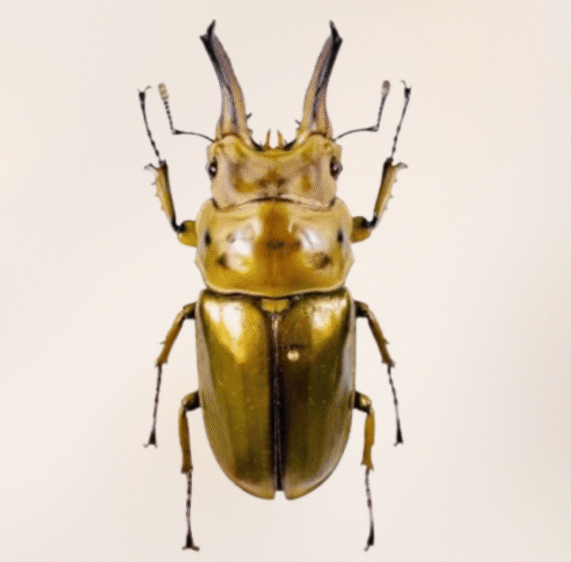

Product Details
Size
5cm - 7.5cm
Temperament
Peaceful
Allotopus rosenbergi (Golden Stag Beetle)
The Allotopus rosenbergi, also called the Golden Stag Beetle, is one of the most sought-after and visually stunning beetles in the insect-keeping world. Known for its shimmering gold body, elegant shape, and gentle temperament, this species makes an excellent addition to any beetle enthusiast's collection. Native to Southeast Asia, especially Malaysia and Indonesia, this beetle thrives in warm and humid environments and is relatively easy to care for, making it suitable for both beginners and seasoned beetle keepers.
🔍 Key Features:
-
Scientific Name: Allotopus rosenbergi
-
Common Name: Golden Stag Beetle
-
Lifespan: 1–2 years (including larval stage)
-
Size: Males grow up to 50–75 mm; females are slightly smaller
-
Temperament: Calm and non-aggressive
-
Difficulty Level: Beginner to Intermediate
🌿 Living Conditions:
To keep your Allotopus rosenbergi healthy and stress-free, mimic its natural tropical habitat:
-
Enclosure: Use a plastic or acrylic terrarium (at least 15x10x10 inches) with a well-ventilated lid.
-
Substrate: Provide 3–5 inches of fermented leaf litter, decaying wood, or coconut husk fiber to allow for burrowing.
-
Temperature: Maintain a stable range of 24–28°C (75–82°F).
-
Humidity: Keep humidity around 70–80%. Mist lightly every 1–2 days to avoid dryness.
-
Lighting: Indirect light only—no strong UV or heat lamps are needed. A dim room is ideal.
-
Hiding Spaces: Add bark, cork wood, or leaf litter for daytime hiding and comfort.
🧑🤝🧑 Tank Mates:
Allotopus rosenbergi is best kept alone, especially males. Here's why:
-
Males can be territorial and may use their mandibles to fight other males.
-
Females may cohabitate temporarily, especially for breeding, but supervision is advised.
-
Avoid keeping them with other beetles or insects unless you're experienced in beetle care.
🍎 Feeding Habits:
These beetles feed on sweet, sugary substances:
-
Primary Food: Beetle jelly (sold in pet stores) is highly recommended—nutrient-rich and clean.
-
Alternative Options: Ripe fruits like bananas, apples, watermelons, or mangoes can be used occasionally.
-
Feeding Tips:
-
Replace fresh food every 1–2 days to avoid mold.
-
Place food on a shallow dish or flat surface to prevent substrate contamination.
-
🧽 Care and Maintenance:
-
Clean enclosure weekly—remove waste and old food.
-
Replace substrate every 4–6 weeks or sooner if it smells or shows mold.
-
Avoid over-handling—though docile, handling too often can stress them.
-
Monitor for signs of health issues: inactivity, refusal to eat, or dry, cracked exoskeleton may suggest poor habitat conditions.
🐛 Larvae and Breeding:
-
If you're breeding them, note that females lay eggs in rotten wood or substrate.
-
Larvae are large and require a deep container with nutrient-rich compost or decayed wood.
-
Larval stage can last up to 10–12 months before pupating.
❤️ Why You’ll Love Allotopus rosenbergi:
-
Visually stunning—shiny metallic gold makes it a display-worthy pet.
-
Easy to maintain with minimal noise or mess.
-
Great for education, insect collections, and nature displays.
-
Ideal for those interested in exotic, low-maintenance pets.
Allotopus Rosenbergi
Product Options
5cm
6cm
7cm
7.5cm
Delivery
Quantity
 HansInsect
HansInsect Aquarium Fishes, Tanks & Supplies From HansInsect


